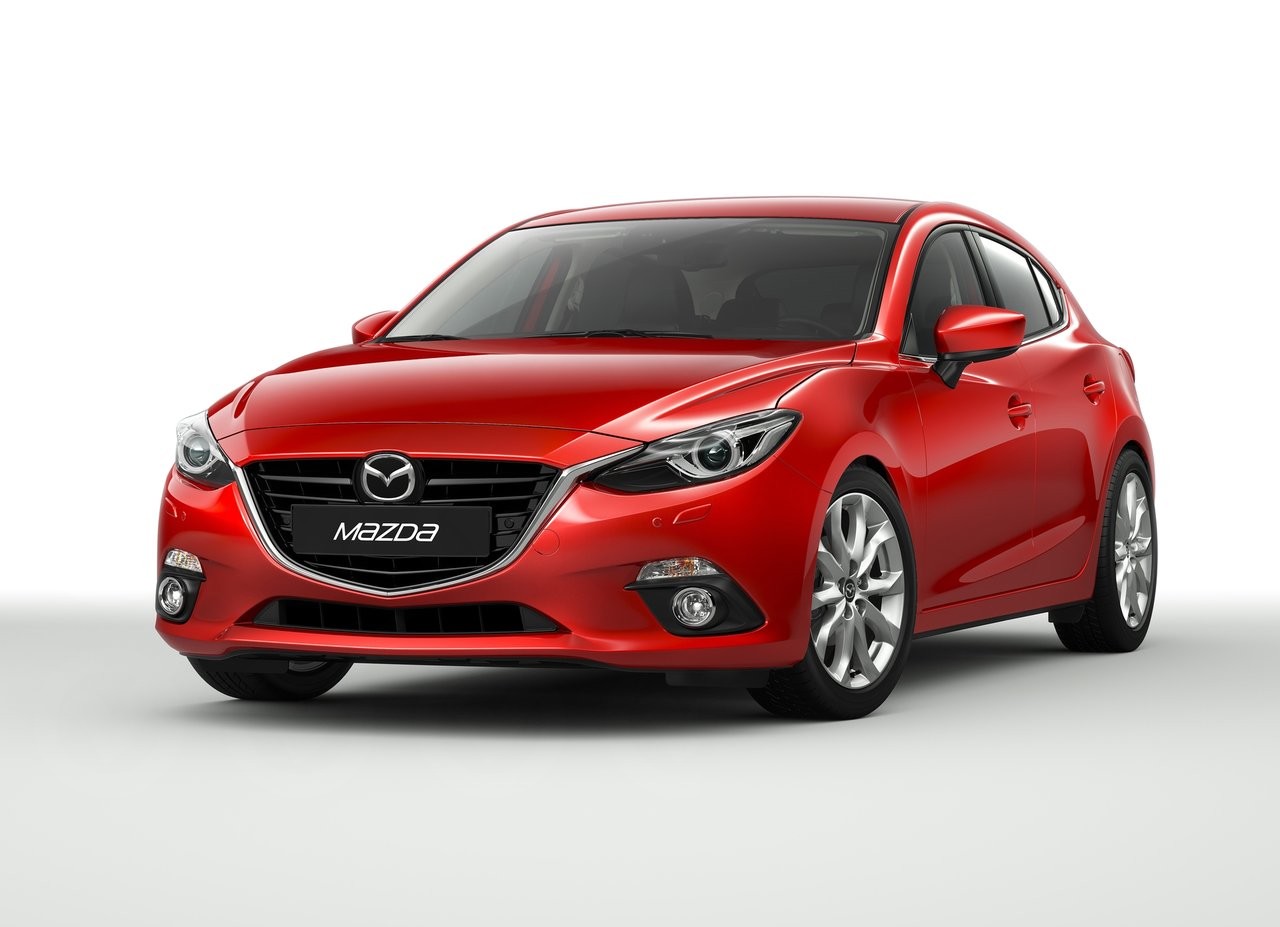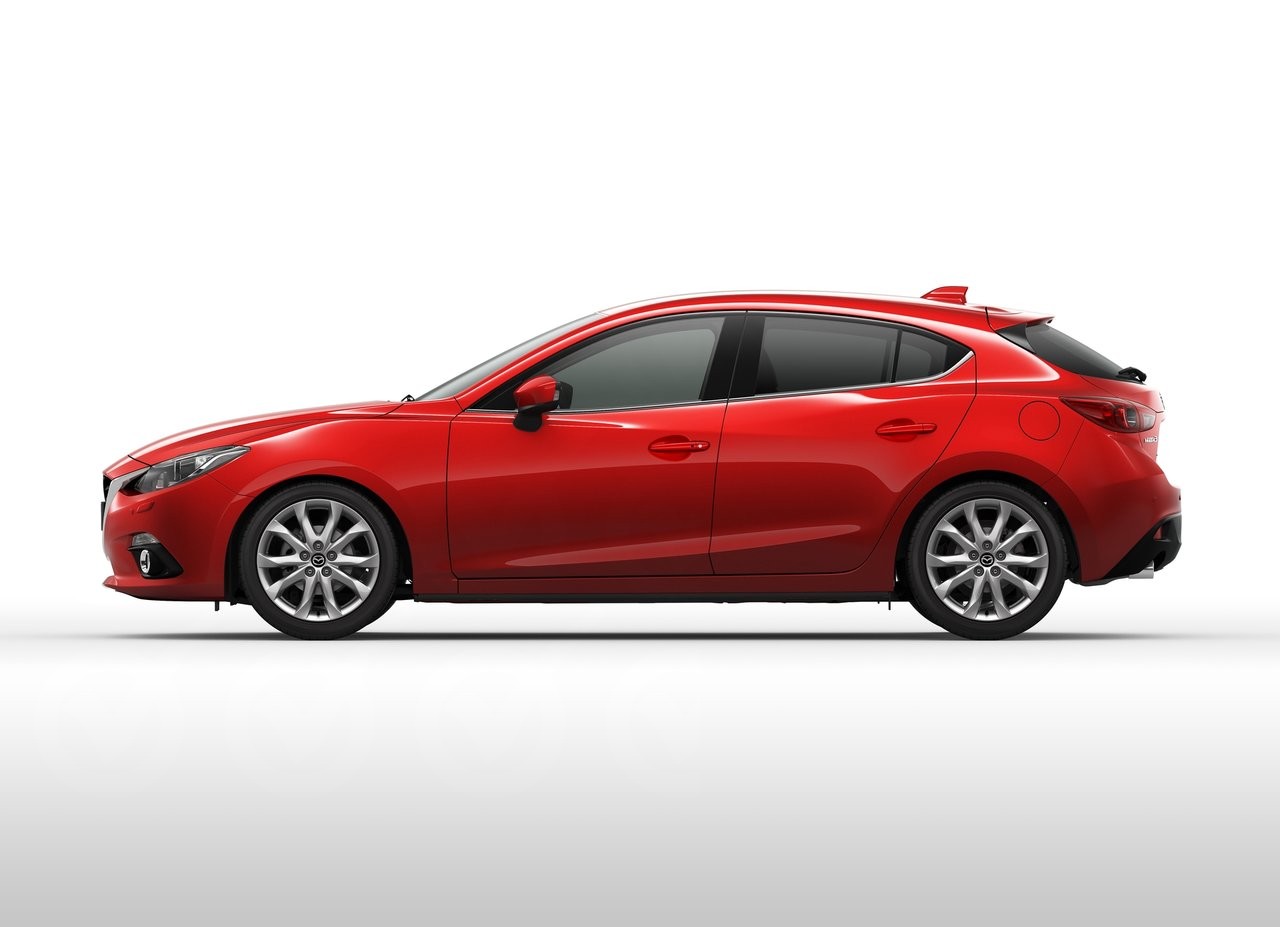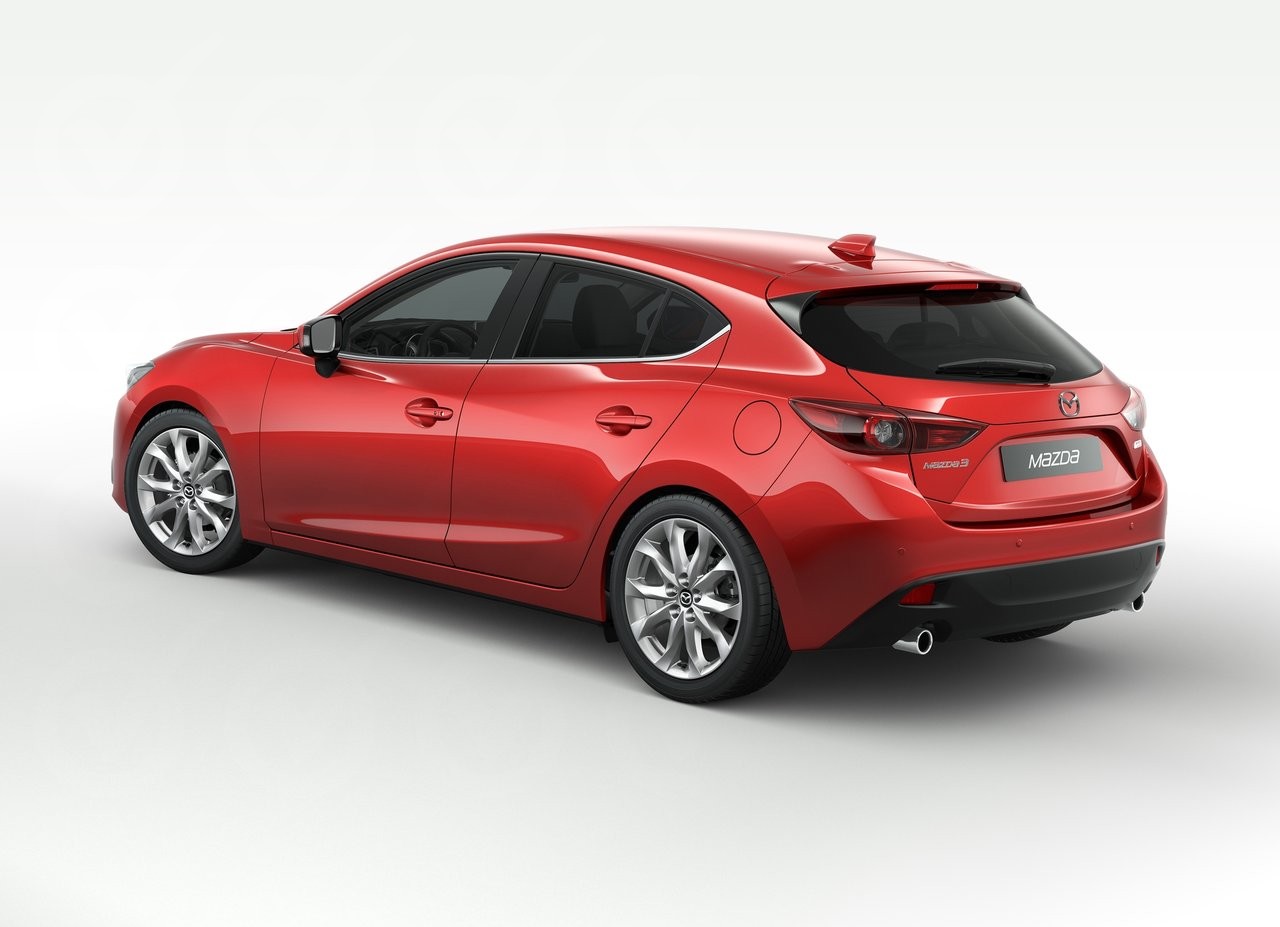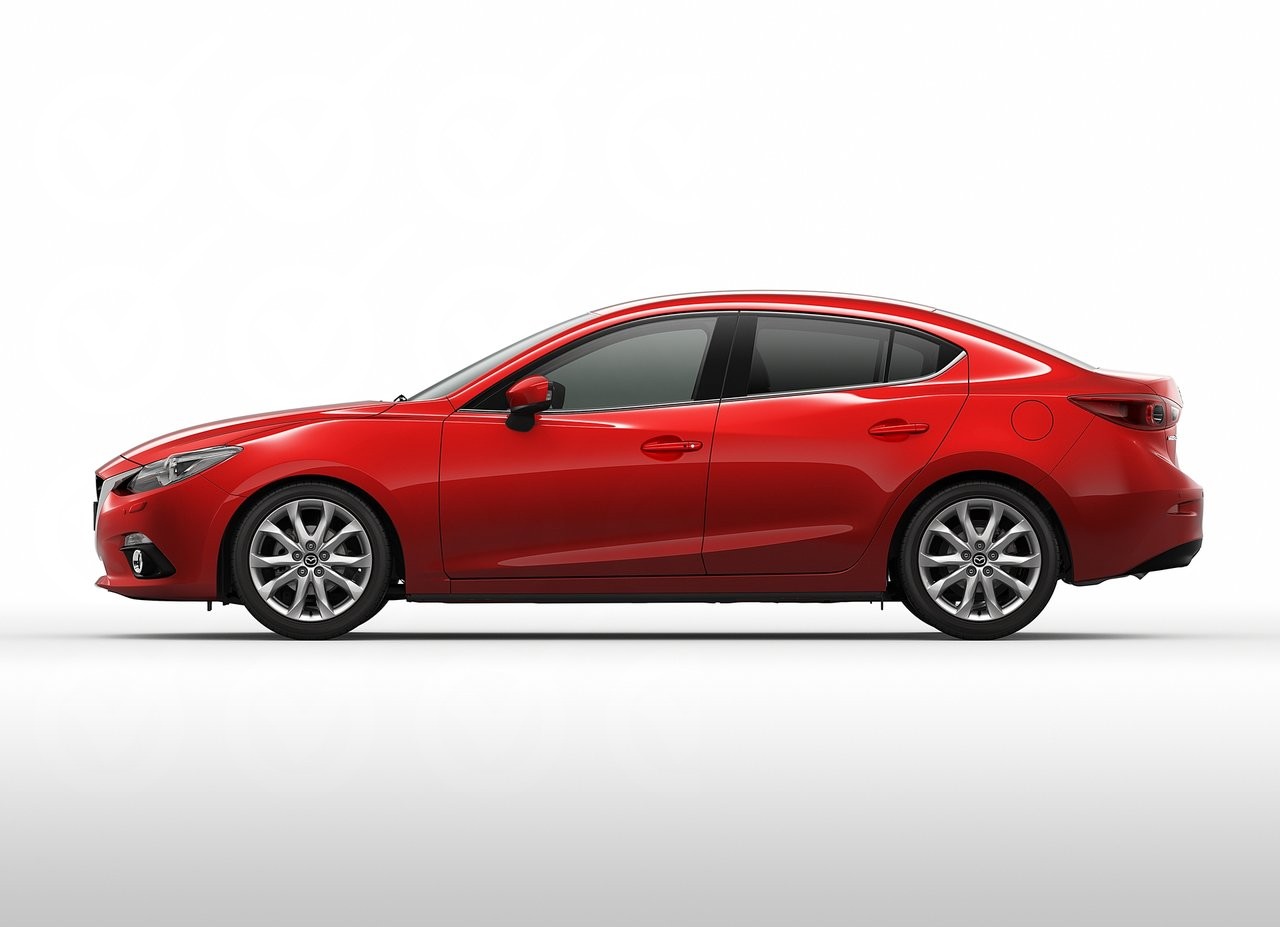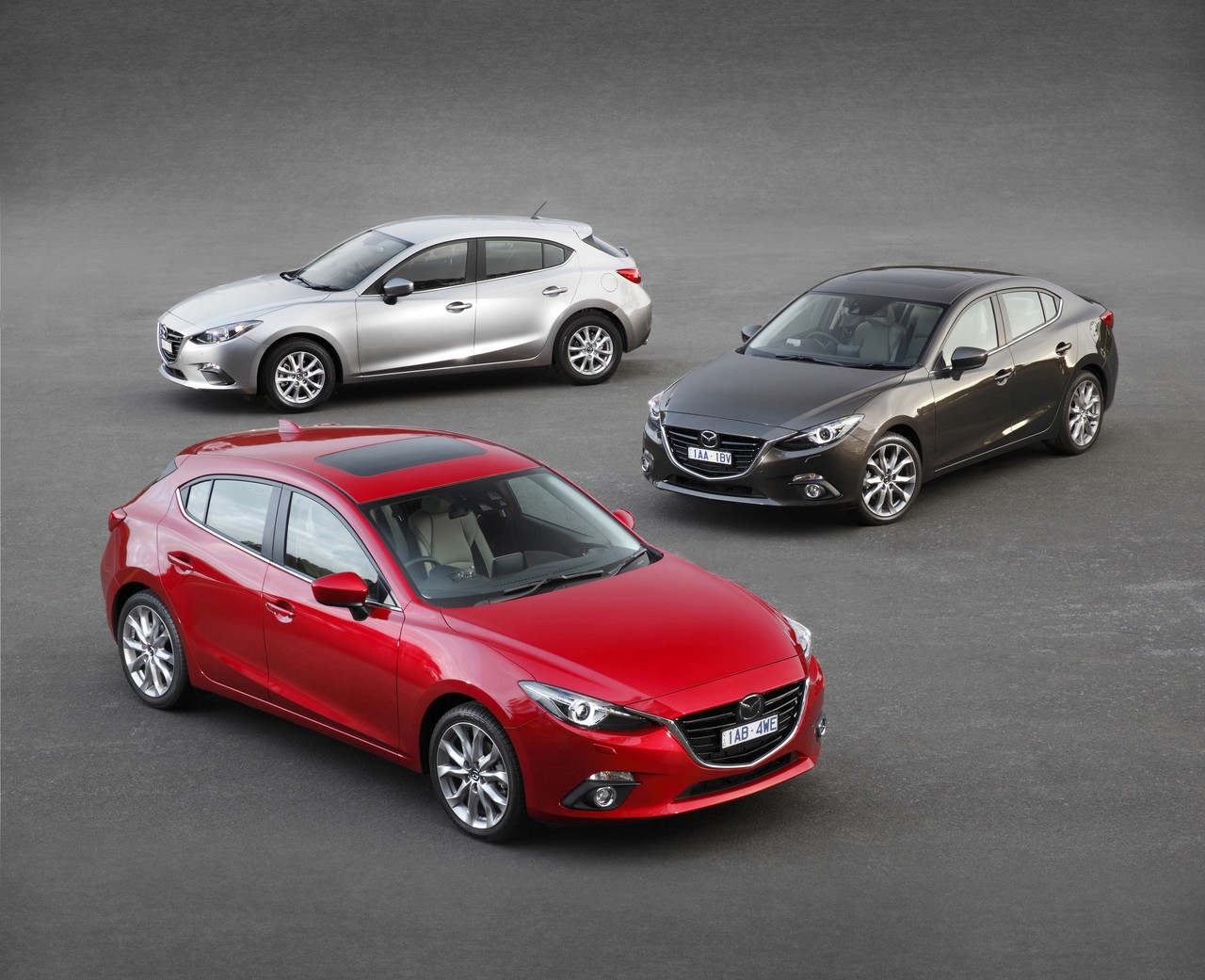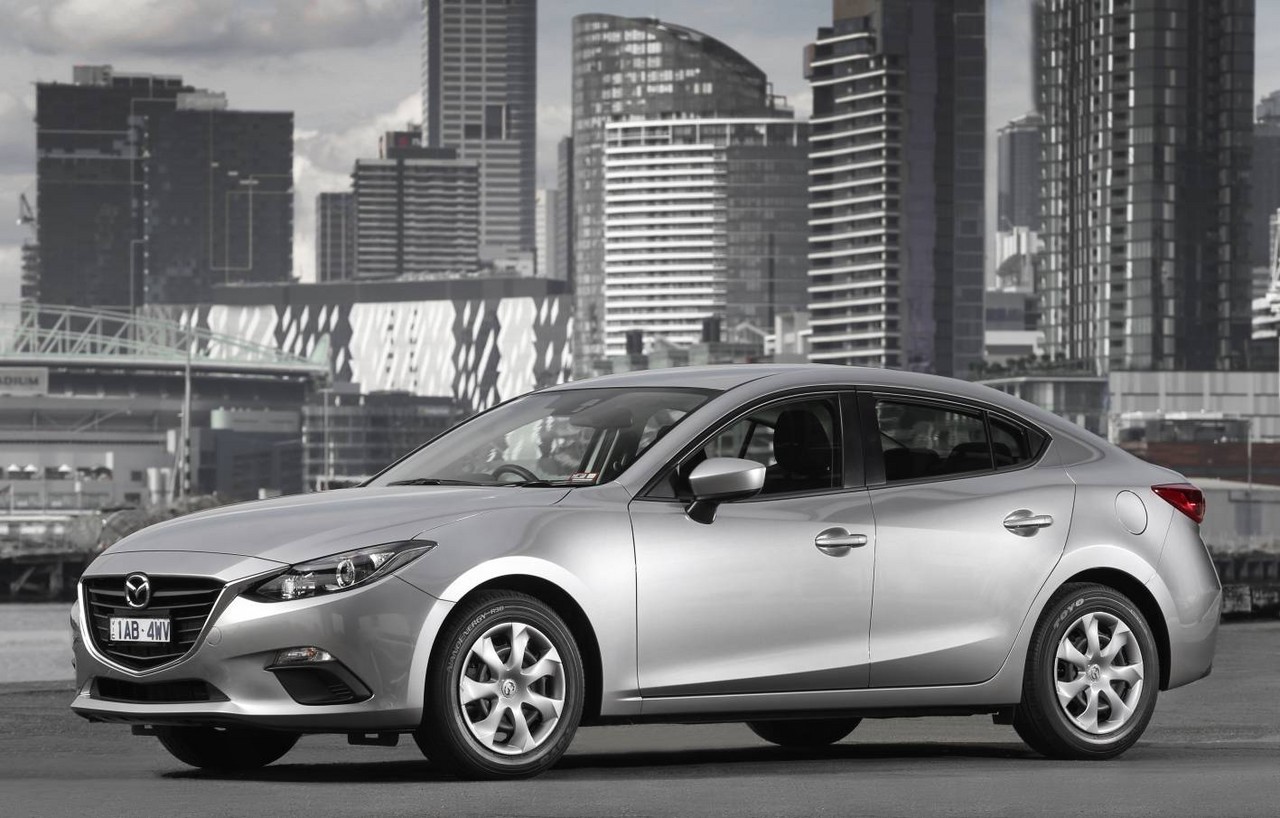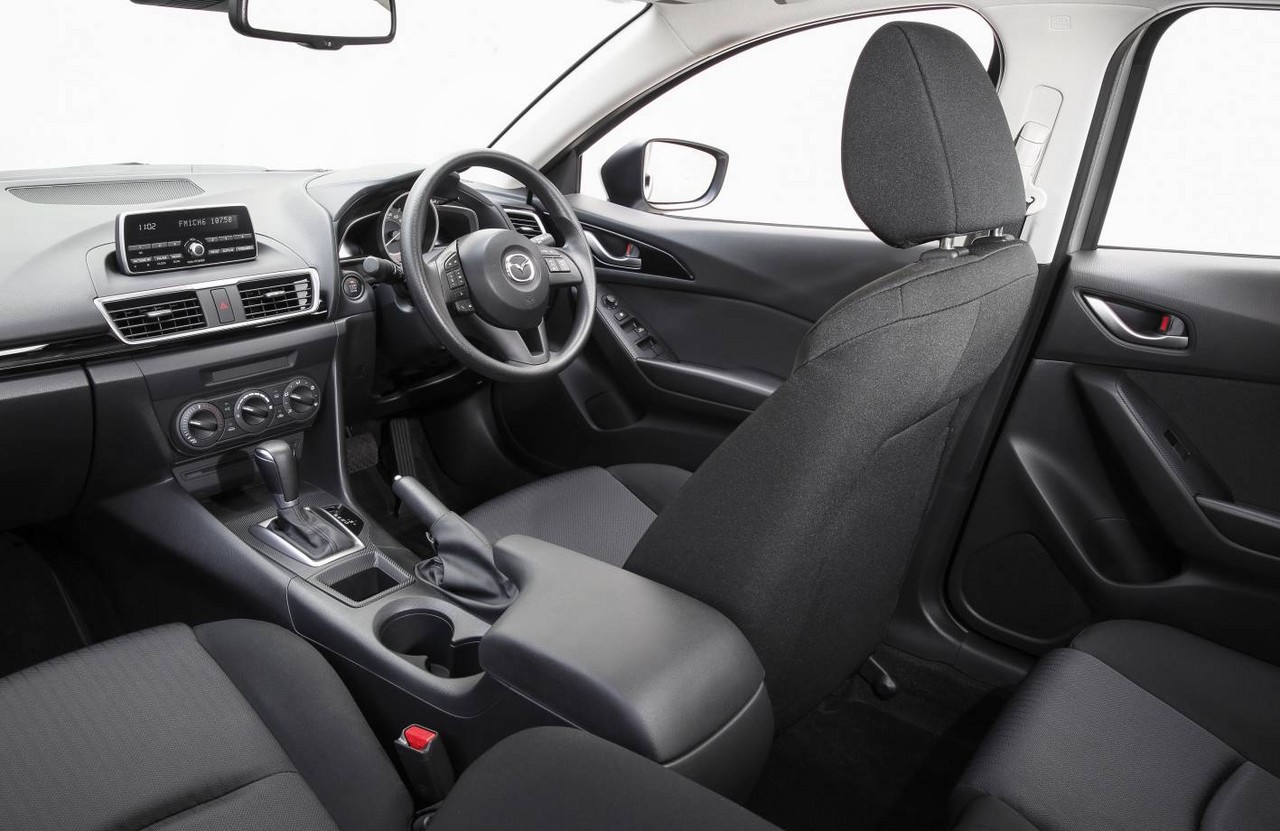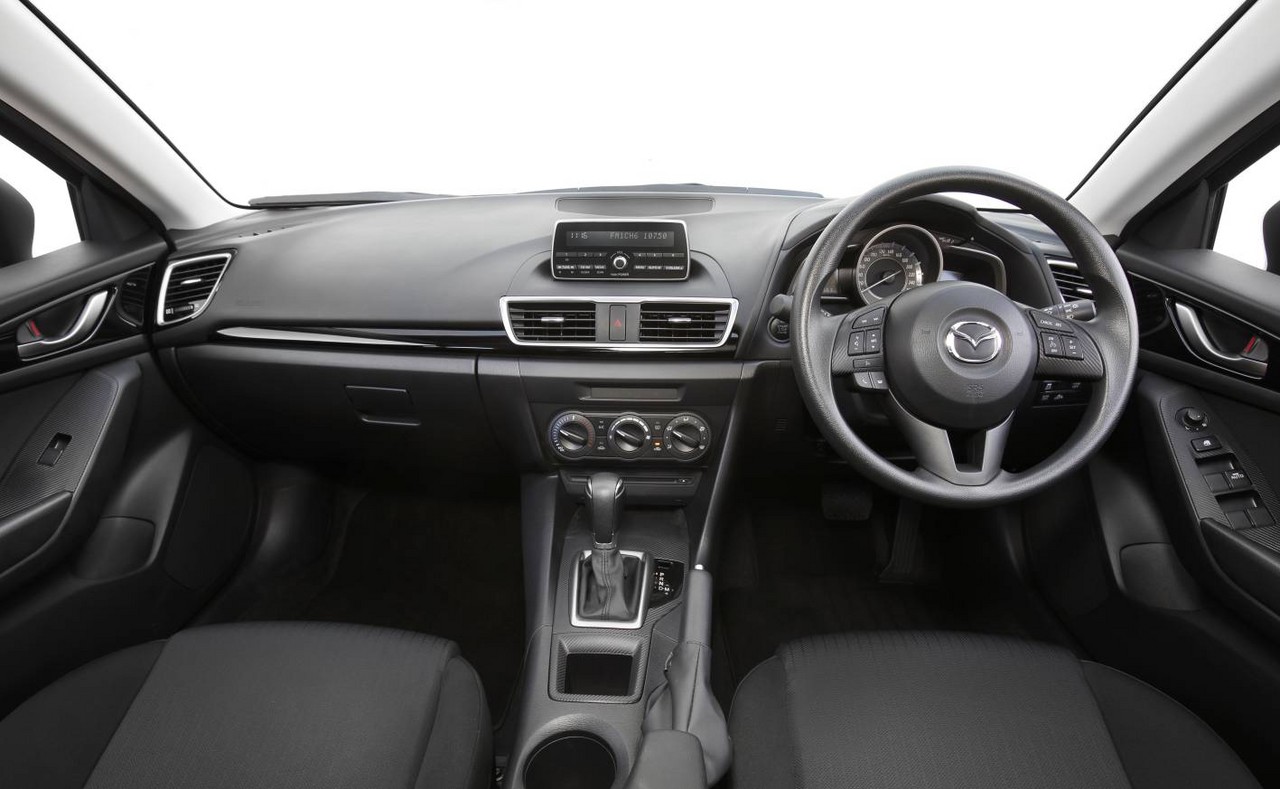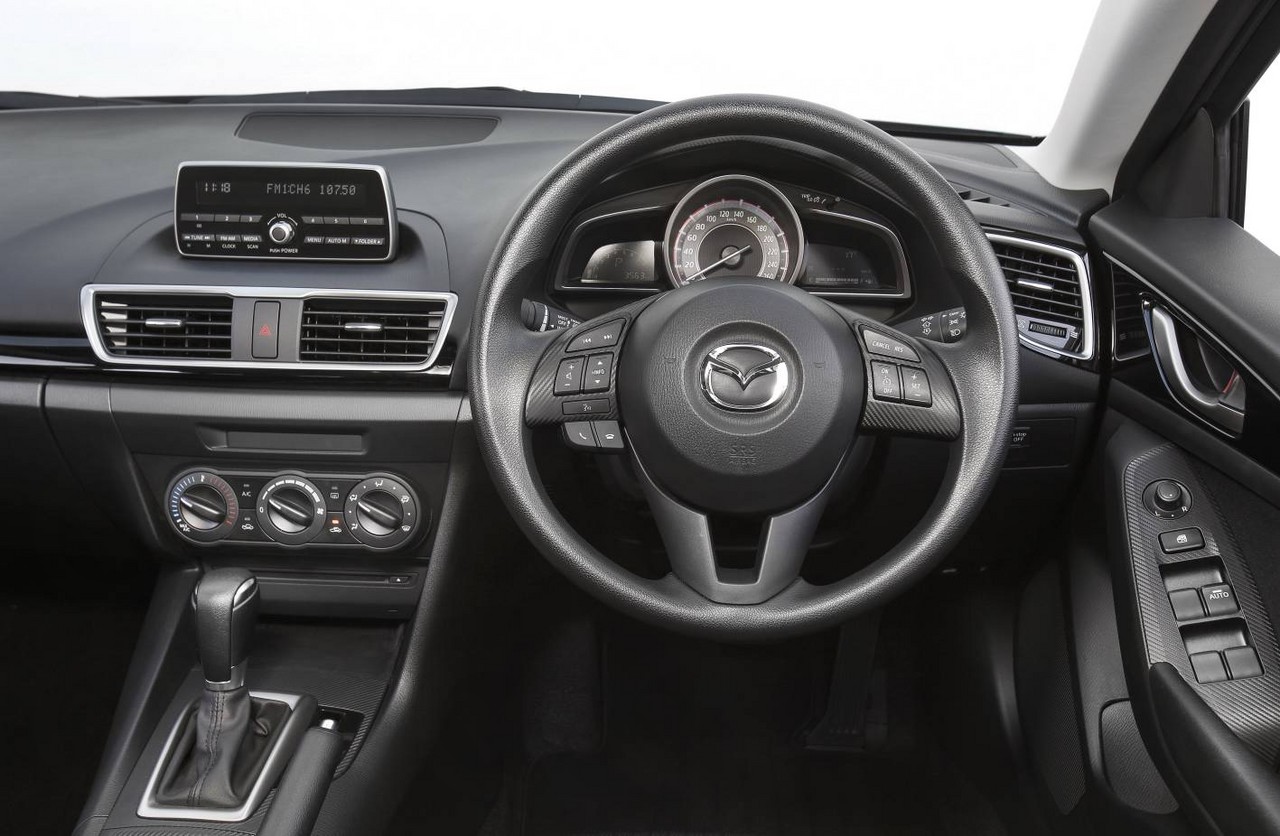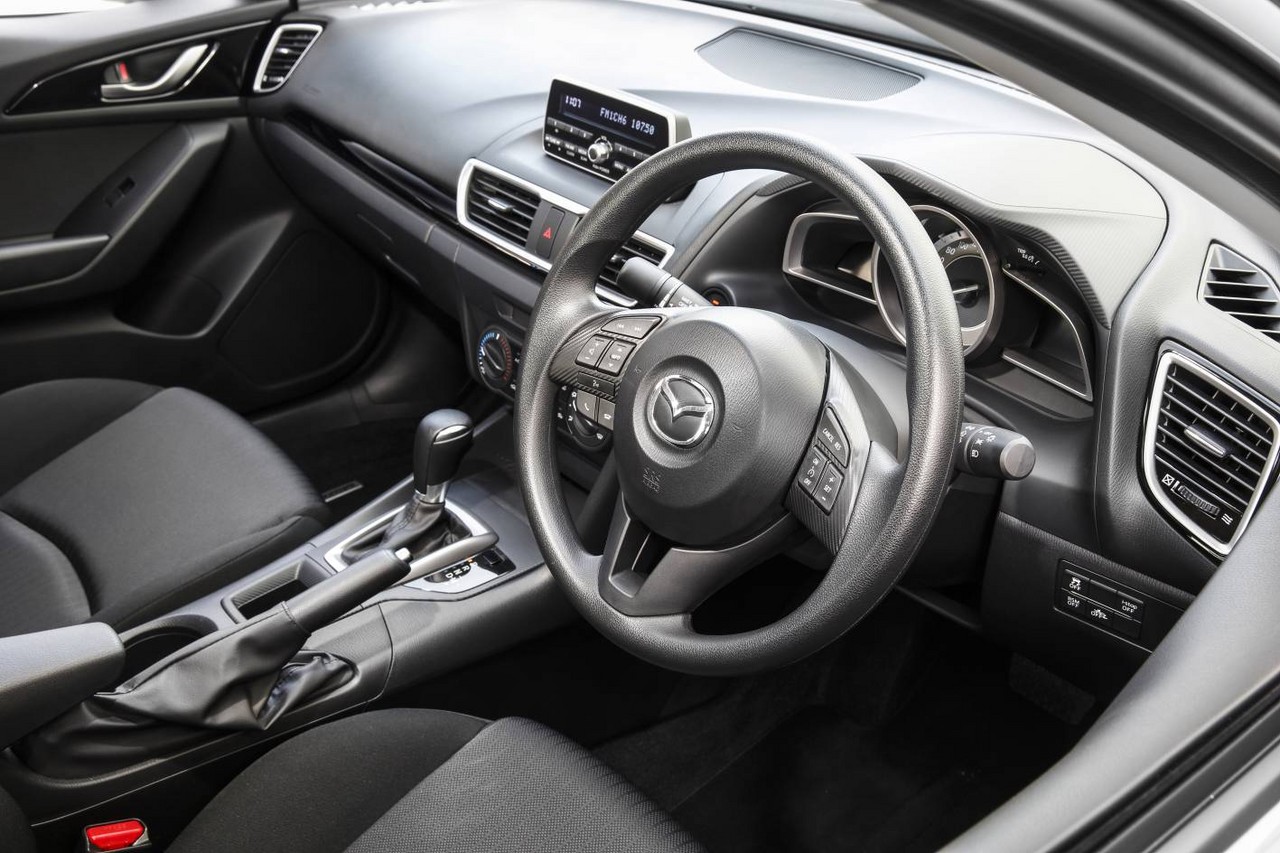
- SP25 variants have responsive drivetrains
- Excellent dynamics
- High quality interior fit and finish
- Accurate steering
- Generally excellent ride/handling balance…
- … though ride is firm on 18-inch wheels
- Interior noise
- For hatch, small cargo bay
Overview
Released in Australia in November 2013, the Mazda BM Mazda3 was available as a hatchback and sedan. Manufactured in Hofu, Japan, the front-wheel drive Mazda3 was initially available with by 2.0- and 2.5-litre four-cylinder petrol engines that were mated to six-speed manual and automatic transmissions. The BM Mazda3 range initially consisted of Neo, Maxx, Touring, SP25, SP25 GT and SP25 Astina variants (see table below). In August 2014, however, a 2.2-litre turbo-diesel engine was introduced for the XD Astina.
SkyActiv petrol and diesel engines
Of the engines,
- The 2.0-litre PE-VPS ‘SkyActiv-G’ and 2.5-litre PY-VPS ‘SkyActiv-G’ petrol engines had aluminium blocks and cylinder heads, direct fuel injection, double overhead camshafts, four valves per cylinder, variable valve timing for the intake and exhaust valves (Mazda’s ‘dual S-VT’), a balance shaft, a 4-2-1 exhaust system with an extended manifold structure to reduce residual exhaust gas in the combustion chamber and compression ratios of 13:1; and,
- From the XD Astina, the 2.2-litre SH-VPTR ‘SkyActiv-D’ turbo-diesel engine had an aluminium block, common-rail direct-injection, a two-stage turbocharger with two turbines (a smaller turbine for low rpm and a larger turbine for more power when required) and a compression ratio of 14:1 (the world’s lowest for a diesel engine).
Both engines were available with six-speed manual and automatic transmissions and fitted with Mazda’s ‘i-stop idle-stop’ system which enabled the engine to shut down when the vehicle is stationary to minimise fuel consumption. The SkyActiv-D engine, however, was also fitted with Mazda’s ‘i-ELOOP’ system which used a variable-voltage alternator to convert kinetic energy into electrical energy when the driver lifted their foot off the accelerator. The energy would then be stored in a double-layer capacitor and used to power the vehicle’s electrical systems, thereby reducing fuel consumption.
| Engine | Variant | Trans. | Peak power | Peak torque |
|---|---|---|---|---|
| 2.0-litre PE-VPS petrol I4 | Neo, Maxx, Touring |
6sp man., 6sp auto |
114 kW at 6000 rpm | 200 Nm at 4000 rpm |
| 2.5-litre PY-VPS petrol I4 | SP25, SP25 GT, SP25 Astina |
6sp man., 6sp auto |
138 kW at 5700 rpm | 250 Nm at 3250 rpm |
| 2.2-litre SH-VPTR turbo-diesel I4 | XD Astina | 6sp man., 6sp auto |
129 kW at 4500 rpm | 420 Nm at 2000 rpm |
Dimensions and chassis
Compared to its BL Mazda3 predecessor, the BM Mazda3 hatchback was the same length (4460 mm), but 40 mm wider (1795 mm), 15 mm lower (1455 mm) and had a 60 mm longer wheelbase (2700 mm). Relative to the BM Mazda3 hatchback, the sedan was 120 mm longer (4580 mm), though the other dimensions were unchanged. Notwithstanding the changes in dimensions, the proportions also changed with the front overhang reduced by 55 mm and the base of the A-pillars moved 100 mm rearwards. The BM Mazda3 hatchback and sedan had drag coefficients of 0.28 Cd and 0.26 Cd, respectively.
According to Mazda, the BM Mazda3 chassis had a ‘dual brace structure’ and the increased use of high-tensile steel contributed to a 31 per cent increase in torsional rigidity relative to its hatchback predecessor and 28 per cent for the sedan.
Suspension
The BM Mazda3 had MacPherson strut front suspension, independent multi-link rear suspension and electric power-assisted steering with a 14:1 gear ratio (compared to 16.2:1 for the BL Mazda3).
Safety equipment
Standard safety equipment for the Mazda BM Mazda3 included dual front airbags, front side airbags, full-length curtain airbags (i.e. for front and rear occupants), ABS, electronic brake force distribution, brake assist, electronic stability control, traction control and front seatbelts with pretensioners and load limiters.
The Mazda3 SP25 Astina and XD Astina were further equipped with Mazda’s ‘i-ACTIVSENSE’ safety technologies which included –
- Forward Obstruction Warning (FOW): used a milliwave radar to monitor the path ahead and alerted the driver if they were too close to the vehicle ahead and at risk of a collision. FOW operated when the vehicle was travelling at speeds between 15 km/h and 145 km/h;
- Smart Brake Support (SBS) used the milliwave radar to detect vehicles or obstructions ahead and operated at speeds between 15 km/h and 145 km/h. If an object was detected and the driver failed to react, FOW would sound an alert and SBS pressurise the brakes. If the driver continued to close on the vehicle or obstacle ahead, preliminary braking would commence. If the system determined that an accident could not be prevented, more forceful second-stage braking would be initiated;
- Smart City Brake Support (SCBS): operating at speeds between 4 km/h and 30 km/h, SCBS used a near-infrared sensor that was mounted in the upper part of the windshield. If a vehicle or obstacle was detected and a high risk of collision was determined, the brakes would be pressurised. If the driver failed to take evasive action, the brakes would be automatically applied to prevent or reduce the severity of the collision;
- Blind Spot Monitoring (BSM): used a quasi-milliwave radar and operated at speeds in excess of 10 km/h to detect vehicles approaching from behind or in the driver’s blind spot (on either side of the vehicle). BSM could also warn the driver when they activated their indicators to change lanes (Rear Cross Traffic Alert or RCTA);
- Lane Departure Warning (LDW): used a camera to detect lane markings and warn the driver of unintentional lane departures when travelling at speeds of 65 km/h or above;
- Radar Cruise Control: used the milliwave radar and operated at speeds between 30 km/h and 145 km/h to maintain a safe distance from the vehicle ahead. Radar Cruise Control also included autonomous application of the brakes when required; and,
- High Beam Control (HBC): automatically switched the headlights from high to low beams when oncoming traffic was detected by the monocular camera. Low beams would also be activated when driving in brightly lit urban areas or at speeds below 30 km/h.
Euro NCAP testing
In Euro NCAP testing , the BM Mazda3 – fitted with a 2.0-litre petrol engine – received a five star safety rating which included a 93 per cent adult occupant protection rating and an 86 per cent child occupant protection rating. In the offset crash test, occupant protection was generally rated as good although protection of the driver’s chest and lower legs was rated as adequate. Maximum points were awarded in the side impact test though, in the more severe pole test, chest protection was rated as weak.
Based on the Euro NCAP testing, the BM Mazda3 received a five star adult occupant protection rating from ANCAP with a score of 36.4 out of 37.
Features: Mazda3 Neo, Maxx and Touring
Standard features for the Mazda3 Neo included 16-inch steel wheels with 205/60 R16 92V tyres, a four speaker sound system with a CD player, MP3 compatibility and auxiliary inputs (3.5 mm/USB/iPod), Bluetooth hands-free phone and audio connectivity, air conditioning, cruise control, cloth seat trim, 60/40 split and folding rear seats, remote central locking, power windows and mirrors, tilt and telescopic steering wheel adjustment, a height adjustable driver’s seat, push-button engine start, a trip computer and an immobiliser; hatchback models were also fitted with a rear spoiler.
In February 2015, standard features for the Mazda3 were extended to include 16-inch alloy wheels and rear parking sensors.
Beyond this, the Mazda3 Maxx added 16-inch alloy wheels, a six speaker sound system, Mazda’s ‘MZD Connect’ connectivity system, satellite navigation, a reversing camera, a leather-wrapped steering wheel and gears shift knob, and a folding rear armrest; models with automatic transmissions also featured steering wheel gearshift paddles. From February 2015, both the Mazda3 Maxx and Touring were fitted with front fog lights.
The ‘MZD Connect’ system worked in conjunction with a synchronised smartphone to provide an Internet connection and communication function. MZD Connect had the following capabilities when synchronised to a smartphone:
- could provide access to Internet Radio such as Aha, Pandora and Stitcher;
- read aloud email and short messages – including Twitter tweets and Facebook news feed entries – while the vehicle was in motion using text-to-voice technology;
- post audio messages using the Shout function; and,
- enable the driver to search the Internet for locations and set them as target destinations.
A navigation system with data provided on SD cards was also available in conjunction with MZD Connect.
Relative to the Maxx variants, the Mazda3 Touring was further equipped with dual-zone climate control air conditioning, leather seat trim, driver’s seat lumbar adjustment, automatic headlights, rain-sensing wipers and illuminated vanity mirrors.
Features: Mazda3 SP25, SP25 GT, SP25 Astina and XD Astina
Compared to the Maxx, the Mazda3 SP25 featured 18-inch alloy wheels with 215/45 R18 89W tyres, dual-zone climate control air conditioning, front fog lights, automatic headlights, rain-sensing wipers and a proximity key (i.e. ‘advanced keyless entry’); sedan models were also fitted with a rear spoiler.
The Mazda3 SP25 GT was distinguished by its Bose sound system with nine speakers and a 231 watt amplifier, leather seat trim, a six-way power adjustable driver’s seat, heated front seats, daytime LED running lights, directional bi-xenon headlights, heated mirrors, LED tail-lights, rear-view mirror with auto-dimming function, illuminated vanity mirrors and Mazda’s ‘Active Driving Display’, a head-up display which projected speed, navigation directions and other driving information onto a clear panel that was mounted above the instrument cluster.
Finally, the range-topping Mazda3 SP25 Astina and XD Astina were distinguished by their sunroof ands ‘i-ACTIVSENSE’ safety technologies (described under ‘Safety equipment’, above).
Mazda3 Kuroi sports pack
The Mazda3 was available with an optional Kuroi (‘black’ in Japanese) sports pack which consisted of black 18-inch alloy wheels and a black front under spoiler, side skirts, rear under spoiler and door mirror caps. The Kuroi sports pack was available for all Mazda3 variants and could be fitted by any Mazda dealer for $2678; components of the Kuroi sports pack could also be purchased separately.
Brochure
Related links
- Press Kit: Mazda BM Mazda3 (January 2014)
- Mazda News: All-New Mazda3 arrives in Australian showrooms (January 2014)
- Mazda News: All-New Mazda3 Kuroi turns up the style (January 2014)
- Mazda News: Diesel power added to Mazda3 range (May 2014)
- Wikipedia.org: Mazda BM Mazda3
